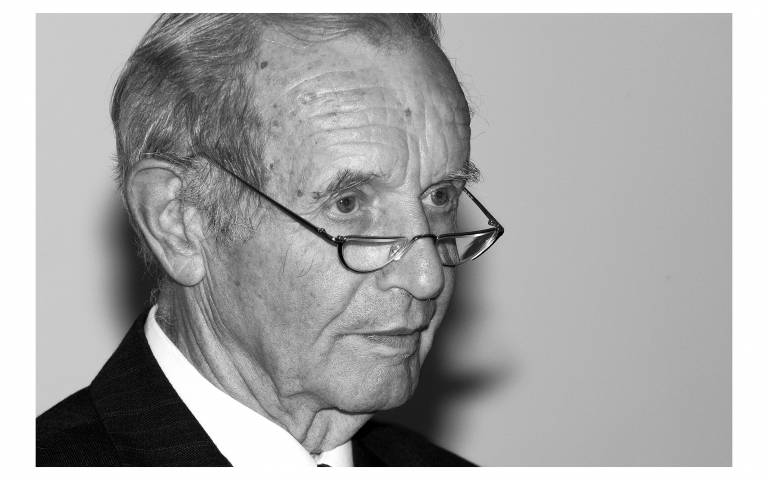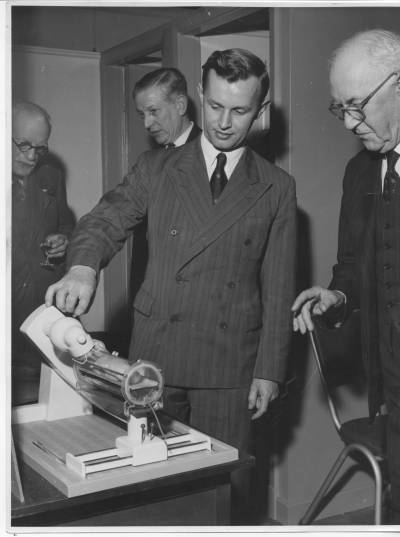A Tribute to Professor John Clifton
26 January 2023

It is with great sadness that we share the news of the passing of Professor John Clifton on Friday 20th January 2023. He died peacefully after a short illness, supported by his closest loved ones. Our thoughts are with his family and all who knew and worked with him.
Born in 1930 and with a career spanning almost 70 years, John was at the forefront of the development and advancement of physics applied to medicine in the UK.
With the growth of the National Health Service, the post-war boom in physics had beneficial consequences for the field of medicine. It was against this backdrop, that John completed his studies at the University of Southampton, graduating in 1955, and started a career in medical radiation physics working at the Royal South Hants Hospital, Southampton.
In 1957, John joined the Medical Physics department of University College Hospital Medical School (UCHMS) and was subsequently appointed Head of Department in 1962. Over the course of the mid-twentieth century, medical physicists pushed the boundaries of physics and new technologies, applying these innovations directly to medical practice. They developed and disseminated new forms of diagnosis and treatment, laying the groundwork for the sophisticated scientific medicine used today. John comments on the serendipitous nature of this time of early innovation.
"Around 1960, we started to see independent departments of medical physics. This enabled them, to apply their skills and their interests to clinical disciplines other than radiotherapy. If you were in a large teaching hospital, or a district general hospital, then you had the opportunity to work with other clinicians. This leads one to reflect on the fact that a lot of what one does in medical physics, in fact, is a bit of serendipity.
Now if I look back to 1962, at that time hyperbaric oxygen was all the rage for radiotherapy treatment, because of the work that had been done at Mount Vernon by Harold Gray, and Jack Fowler, of course, was there. At UCH we had a hyperbaric oxygen tank, developed by Vickers Aircraft, with a pressurisation system designed for their aircraft, to pressurise it, and we needed to measure the tissue oxygen tension. So, we applied and got a grant to develop a transducer for measuring tissue oxygen. It was based on the concept that we could do this by looking at the oxygen effect on semiconductors. Needless to say, it didn’t work, but from that work, subsequently, we developed the oxygen catheter. An intra-arterial oxygen catheter that was used in the neonatal department and revolutionised the control of cerebral oxygenation of newborn infants. This was a classic example of something that didn’t work in one area, but because of the range of interests that the department had, it had been taken to another area, with another physician who was very interested, and it went on from there."

Model of the Hunslet Rotating Cobalt Unit with Vickers Hyperbaric Oxygen Chamber. Professor John Clifton wrote: ‘I am demonstrating the system to Sir Henry Dale of the Wellcome Trust. c. 1962. The man behind me is Dr Himsworth, Chairman of the UCH Medical Committee at that time.’
In 1981, UCHMS became part of University College London (UCL) and John was appointed Professor of Medical Physics. Seven years later, the Middlesex Hospital Medical School merged with UCL which resulted in creation of the academic department; UCL Medical Physics, led by John. In 1990, John was appointed the fourth Joel Professor of Physics Applied to Medicine in the University of London.
Professor Alan Cottenden MBE, now Emeritus Professor of Incontinence Technology, remembers John when he joined the department:
“John was Head of Department when I joined UCL in 1984 and he was very welcoming and supportive as I found my feet. He was a good and encouraging listener. Following our discussions, I often discovered that - without mentioning it to me - he had quietly done or said something somewhere that would smooth the way. A lovely man.”
Speaking in 2005 at the Witness Seminar held by the Wellcome Trust Centre, John commented on the decline in popularity of physics as a career path in the late 1970’s, with some fearing that academic medical physics would disappear altogether, followed by a revival with the rise of undergraduate degrees in medical physics in the early 1980’s:
“Effectively, what had been academic medical physics for medical people was now applied medical physics for the benefit of the patient. In the last decade we have seen the numbers of chairs of medical physics increase quite dramatically; medical physics is developing quite rapidly in a number of areas, with a great deal more academic standing than it had before and medical physics departments, not in the Faculty of Medicine as they were, but in the Faculty of Science.”
John retired from UCL in 1992, becoming an Emeritus Professor of Physics as applied to Medicine, and a decision was taken to split the Medical Physics department forming a "joint" department; one half remaining an academic department within the university, while the other becoming a department within the University College London Hospital NHS Trust, underpinning the department’s partnership and collaboration with clinicians and scientists at one of the UK’s leading teaching hospitals.
Current Head of UCL Medical Physics and Biomedical Engineering, Professor Andy Nisbet states that
“Professor Clifton was not only instrumental in the development of Medical Physics and Biomedical Engineering at UCL and UCLH but his contributions to the field on a national and international scale are significant and it is very fitting that we have a student award named in his honour”
As well as the profound influence John had in shaping UCL Medical Physics and Biomedical Engineering into the department it is today, John’s impact is felt globally; he was President of the Hospital Physicists’ Association (now the Institute of Physics and Engineering in Medicine) from 1976 to 1978, Honorary Editor of Physics in Medicine and Biology from 1979 to 1983 and he initiated the formation of the European Federation of Organizations for Medical Physics (EFOMP) in 1978, and was the founding President of the Federation from 1980 to 1984.
The John Clifton Prize was initiated in 2011 in his honour and is awarded by the Department to the most outstanding performance from a non-final year undergraduate student.
John leaves behind him a significant legacy that will be felt by generations to come.
Links
- Institute of Physics and Engineering in Medicine (IPEM)
- European Federation of Organizations for Medical Physics (EFOMP)
- UCL Medical Physics and Biomedical Engineering
- Development of Physics Applied to Medicine in the UK, 1945–1990 - The transcript of Witness Seminar held by the Wellcome Trust Centre for the History of Medicine at UCL, London, on 5 July 2005
 Close
Close

